Experimental Investigation on Mechanism of Latent Heat Reduction of Sodium Acetate Trihydrate Phase Change Materials
Abstract
1. Introduction
2. Materials and Methods
2.1. Materials
2.2. Preparation of SAT Composite PCMs
2.3. Characterization
2.4. Supercooling Determination
2.5. Heat Storage Capacity Determination
2.6. Thermal Stability Determination
3. Results and Discussion
3.1. Influence of DSP on Supercooling
3.2. The Analysis of Latent Heat Reduction
3.3. The Analysis of Inhibiting Latent Heat Reduction
4. Conclusions
Author Contributions
Funding
Conflicts of Interest
References
- Shchukina, E.M.; Graham, M.; Zheng, Z.; Shchukin, D.G. Nanoencapsulation of phase change materials for advanced thermal energy storage systems. Chem. Soc. Rev. 2018, 47, 4156–4175. [Google Scholar] [CrossRef]
- Zalba, B.; Marín, J.M.A.; Cabeza, L.F.; Mehling, H. Review on thermal energy storage with phase change: materials, heat transfer analysis and applications. Appl. Therm. Eng. 2003, 23, 251–283. [Google Scholar] [CrossRef]
- Lin, Y.; Jia, Y.; Alva, G.; Fang, G. Review on thermal conductivity enhancement, thermal properties and applications of phase change materials in thermal energy storage. Renew. Sustain. Energy Rev. 2018, 82, 2730–2742. [Google Scholar] [CrossRef]
- Pandey, A.K.; Hossain, M.S.; Tyagi, V.V.; Abd Rahim, N.; Selvaraj, J.A.L.; Sari, A. Novel approaches and recent developments on potential applications of phase change materials in solar energy. Renew. Sustain. Energy Rev. 2018, 82, 281–323. [Google Scholar] [CrossRef]
- Zhang, Y.; Li, X.; Li, J.; Ma, C.; Guo, L.; Meng, X. Solar-driven phase change microencapsulation with efficient Ti4O7 nanoconverter for latent heat storage. Nano Energy 2018, 53, 579–586. [Google Scholar] [CrossRef]
- Hohlein, S.; Konig-Haagen, A.; Bruggemann, D. Thermophysical characterization of MgCl2·6H2O, xylitol and erythritol as phase change materials (PCM) for latent heat thermal energy storage (LHTES). Materials 2017, 10, 444. [Google Scholar] [CrossRef] [PubMed]
- Miró, L.; Gasia, J.; Cabeza, L.F. Thermal energy storage (TES) for industrial waste heat (IWH) recovery: A review. Appl. Energy 2016, 179, 284–301. [Google Scholar] [CrossRef]
- Xu, H.; Romagnoli, A.; Sze, J.Y.; Py, X. Application of material assessment methodology in latent heat thermal energy storage for waste heat recovery. Appl. Energy 2017, 187, 281–290. [Google Scholar] [CrossRef]
- Qian, Z.; Shen, H.; Fang, X.; Fan, L.; Zhao, N.; Xu, J. Phase change materials of paraffin in h-BN porous scaffolds with enhanced thermal conductivity and form stability. Energy Build. 2018, 158, 1184–1188. [Google Scholar] [CrossRef]
- Jin, X.; Zhang, S.; Xu, X.; Zhang, X. Effects of PCM state on its phase change performance and the thermal performance of building walls. Build Env. 2014, 81, 334–339. [Google Scholar] [CrossRef]
- Fang, Y.; Ding, Y.; Tang, Y.; Liang, X.; Jin, C.; Wang, S.; Gao, X.; Zhang, Z. Thermal properties enhancement and application of a novel sodium acetate trihydrate-formamide/expanded graphite shape-stabilized composite phase change material for electric radiant floor heating. Appl. Therm. Eng. 2019, 150, 1177–1185. [Google Scholar] [CrossRef]
- Wang, H.; Guo, L.; Liu, K.; Song, Z.; Wu, L.; Fang, M.; Li, J. Investigation of magnesium nitrate hexahydrate based phase change materials containing nanoparticles for thermal energy storage. Mater. Res. Express 2019, 6, 105512. [Google Scholar] [CrossRef]
- Ma, Z.; Bao, H.; Roskilly, A.P. Study on solidification process of sodium acetate trihydrate for seasonal solar thermal energy storage. Sol. Energy Mater. Sol. Cells 2017, 172, 99–107. [Google Scholar] [CrossRef]
- Dannemand, M.; Johansen, J.B.; Furbo, S. Solidification behavior and thermal conductivity of bulk sodium acetate trihydrate composites with thickening agents and graphite. Sol. Energy Mater. Sol. Cells 2016, 145, 287–295. [Google Scholar] [CrossRef]
- Stritih, U.; Charvat, P.; Koželj, R.; Klimes, L.; Osterman, E.; Ostry, M.; Butala, V. PCM thermal energy storage in solar heating of ventilation air—Experimental and numerical investigations. Sustain. Cities. Soc 2018, 37, 104–115. [Google Scholar] [CrossRef]
- Kenisarin, M.; Mahkamov, K. Salt hydrates as latent heat storage materials: Thermophysical properties and costs. Sol. Energy Mater. Sol. Cells 2016, 145, 255–286. [Google Scholar] [CrossRef]
- Wang, H.; Chen, Y.; Li, J.; Guo, L.; Fang, M. Review of encapsulated salt hydrate core-shell phase change materials. Kona. Powder. Part. J 2020, 1, 2020010. [Google Scholar] [CrossRef]
- Jin, X.; Zhang, S.; Medina, M.A.; Zhang, X. Experimental study of the cooling process of partially-melted sodium acetate trihydrate. Energy Build. 2014, 76, 654–660. [Google Scholar] [CrossRef]
- Zhou, D.; Zhao, C.Y.; Tian, Y. Review on thermal energy storage with phase change materials (PCMs) in building applications. Appl. Energy 2012, 92, 593–605. [Google Scholar] [CrossRef]
- Pielichowska, K.; Pielichowski, K. Phase change materials for thermal energy storage. Prog. Mater. Sci 2014, 65, 67–123. [Google Scholar] [CrossRef]
- Beaupere, N.; Soupremanien, U.; Zalewski, L. Nucleation triggering methods in supercooled phase change materials (PCM), a review. Thermochim. Acta 2018, 670, 184–201. [Google Scholar] [CrossRef]
- Jin, X.; Medina, M.A.; Zhang, X.; Zhang, S. Phase-change characteristic analysis of partially melted sodium acetate trihydrate using DSC. Int. J. 2014, 35, 45–52. [Google Scholar] [CrossRef]
- Hu, P.; Lu, D.-J.; Fan, X.-Y.; Zhou, X.; Chen, Z.-S. Phase change performance of sodium acetate trihydrate with AlN nanoparticles and CMC. Sol. Energy Mater. Sol. Cells 2011, 95, 2645–2649. [Google Scholar] [CrossRef]
- Mao, J.; Dong, X.; Hou, P.; Lian, H. Preparation research of novel composite phase change materials based on sodium acetate trihydrate. Appl. Therm. Eng. 2017, 118, 817–825. [Google Scholar] [CrossRef]
- Garay Ramirez, B.M.L.; Glorieux, C.; San Martin Martinez, E.; Flores Cuautle, J.J.A. Tuning of thermal properties of sodium acetate trihydrate by blending with polymer and silver nanoparticles. Appl. Therm. Eng. 2014, 62, 838–844. [Google Scholar] [CrossRef]
- Cui, W.; Yuan, Y.; Sun, L.; Cao, X.; Yang, X. Experimental studies on the supercooling and melting/freezing characteristics of nano-copper/sodium acetate trihydrate composite phase change materials. Renew. Energy 2016, 99, 1029–1037. [Google Scholar] [CrossRef]
- He, Y.; Zhang, N.; Yuan, Y.; Cao, X.; Sun, L.; Song, Y. Improvement of supercooling and thermal conductivity of the sodium acetate trihydrate for thermal energy storage with α-Fe2O3 as addictive. J. Therm. Anal. Calorim 2018, 133, 859–867. [Google Scholar] [CrossRef]
- Kong, W.; Dannemand, M.; Johansen, J.B.; Fan, J.; Dragsted, J.; Englmair, G.; Furbo, S. Experimental investigations on heat content of supercooled sodium acetate trihydrate by a simple heat loss method. Sol. Energy 2016, 139, 249–257. [Google Scholar] [CrossRef]
- Cabeza, L.F.; Svensson, G.; Hiebler, S.; Mehling, H. Thermal performance of sodium acetate trihydrate thickened with different materials as phase change energy storage material. Appl. Therm. Eng. 2003, 23, 1697–1704. [Google Scholar] [CrossRef]
- Ryu, H.W.; Woo, S.W.; Shin, B.C.; Kim, S.D. Prevention of supercooling and stabilization of inorganic salt hydrates as latent heat storage materials. Sol. Energy Mater. Sol. Cells 1992, 27, 161–172. [Google Scholar] [CrossRef]
- Dannemand, M.; Dragsted, J.; Fan, J.; Johansen, J.B.; Kong, W.; Furbo, S. Experimental investigations on prototype heat storage units utilizing stable supercooling of sodium acetate trihydrate mixtures. Appl. Energy 2016, 169, 72–80. [Google Scholar] [CrossRef]
- Li, X.; Zhou, Y.; Nian, H.; Zhang, X.; Dong, O.; Ren, X.; Zeng, J.; Hai, C.; Shen, Y. Advanced nanocomposite phase change material based on calcium chloride hexahydrate with aluminum oxide nanoparticles for thermal energy storage. Energy Fuel 2017, 31, 6560–6567. [Google Scholar] [CrossRef]
- Ghule, A.; Bhongale, C.; Chang, H. Monitoring dehydration and condensation processes of Na2HPO4·12H2O using thermo-Raman spectroscopy. Spectrochim. Acta. A 2003, 59, 1529–1539. [Google Scholar] [CrossRef]
- Huang, J.; Wang, T.; Zhu, P.; Xiao, J. Preparation, characterization, and thermal properties of the microencapsulation of a hydrated salt as phase change energy storage materials. Thermochim. Acta 2013, 557, 1–6. [Google Scholar] [CrossRef]
- Calbo, L.J. Comprehensive Collection of Coating Additives; Shanghai Science and Technology Academic Press: Shanghai, China, 2000; pp. 336–338. [Google Scholar]


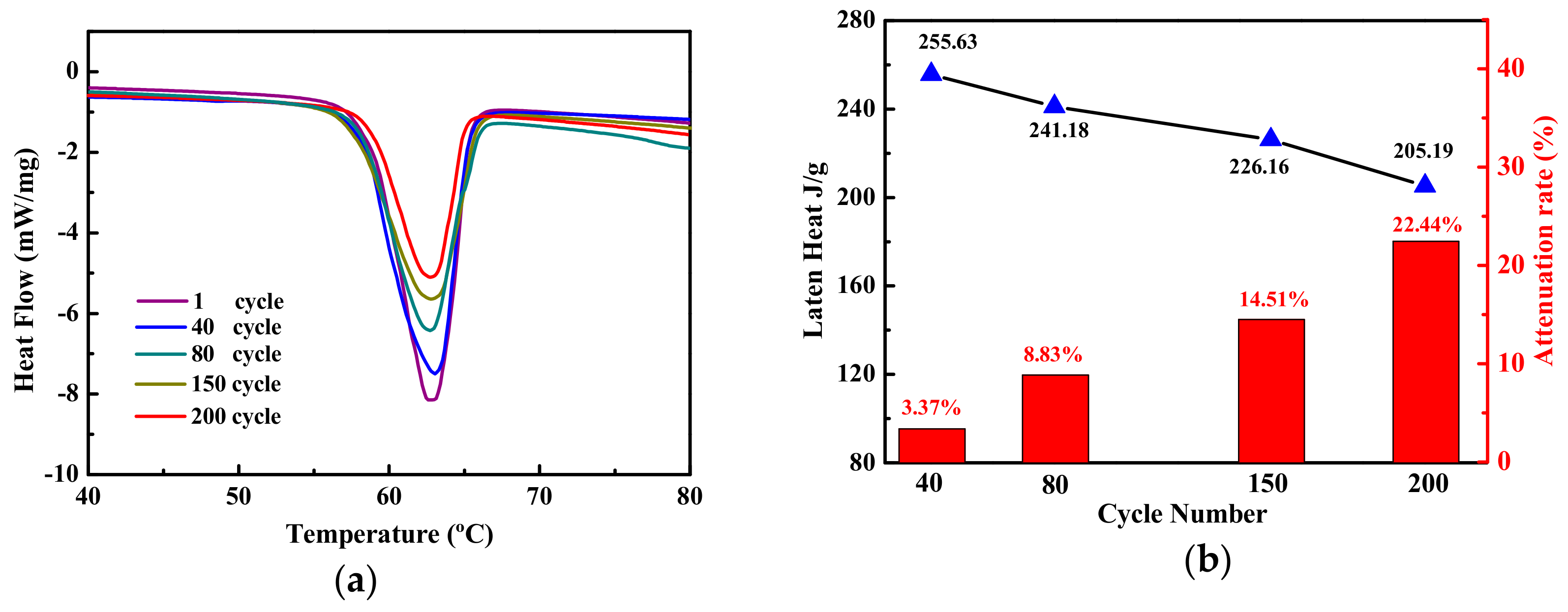
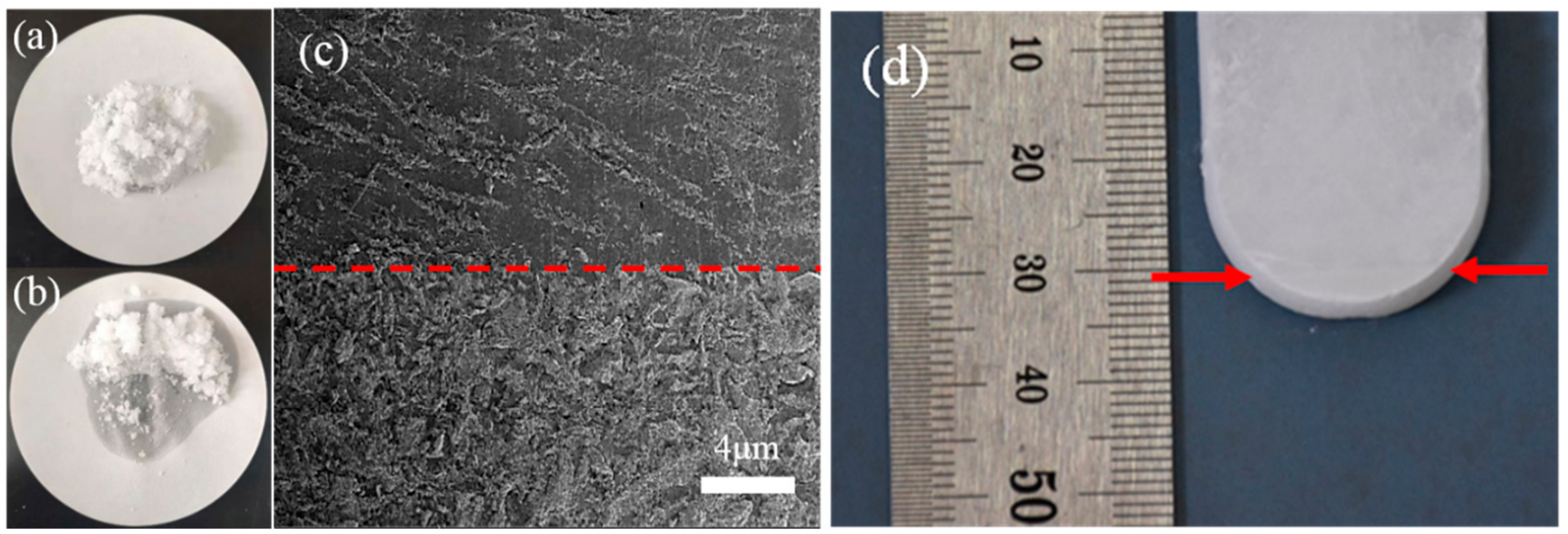
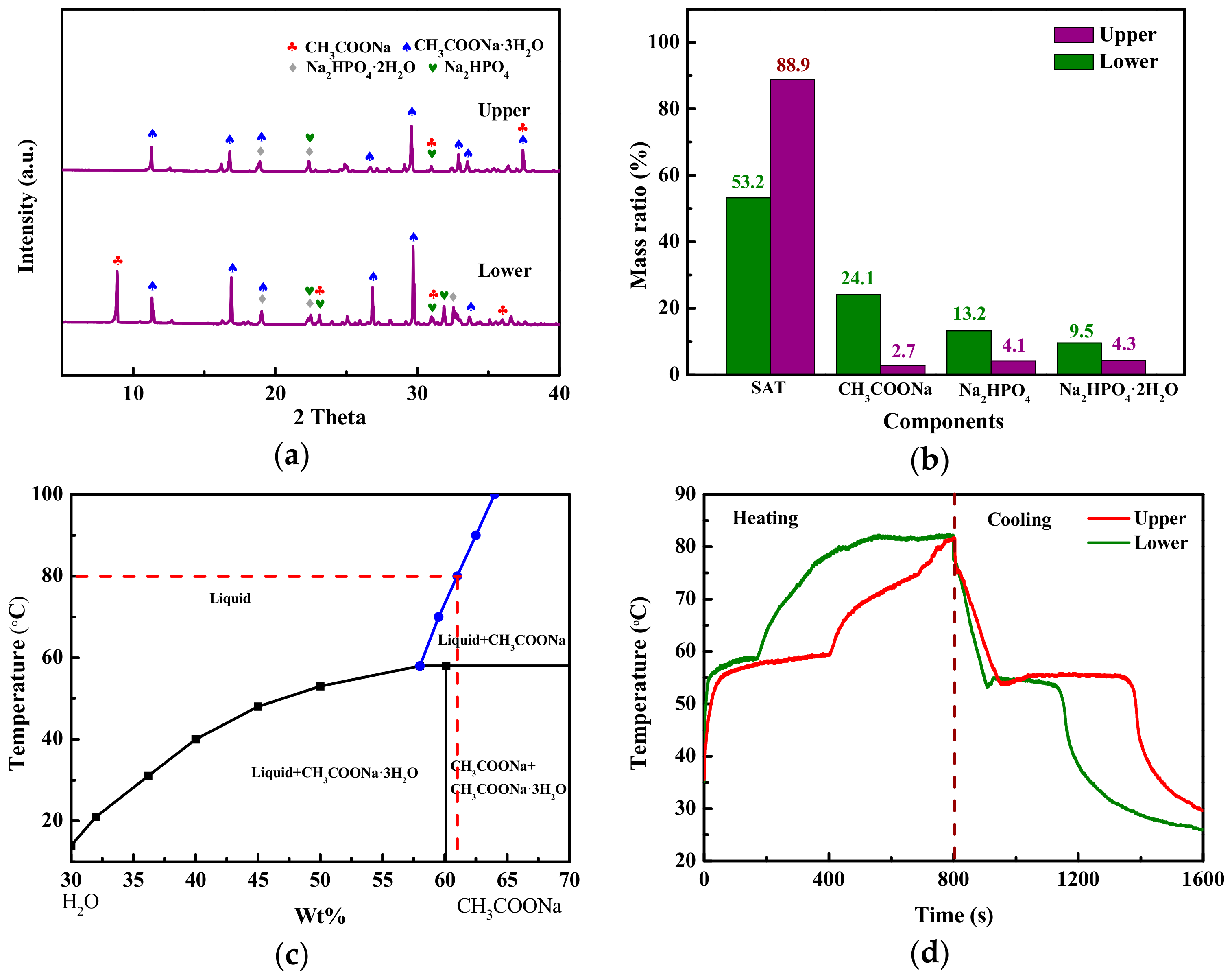

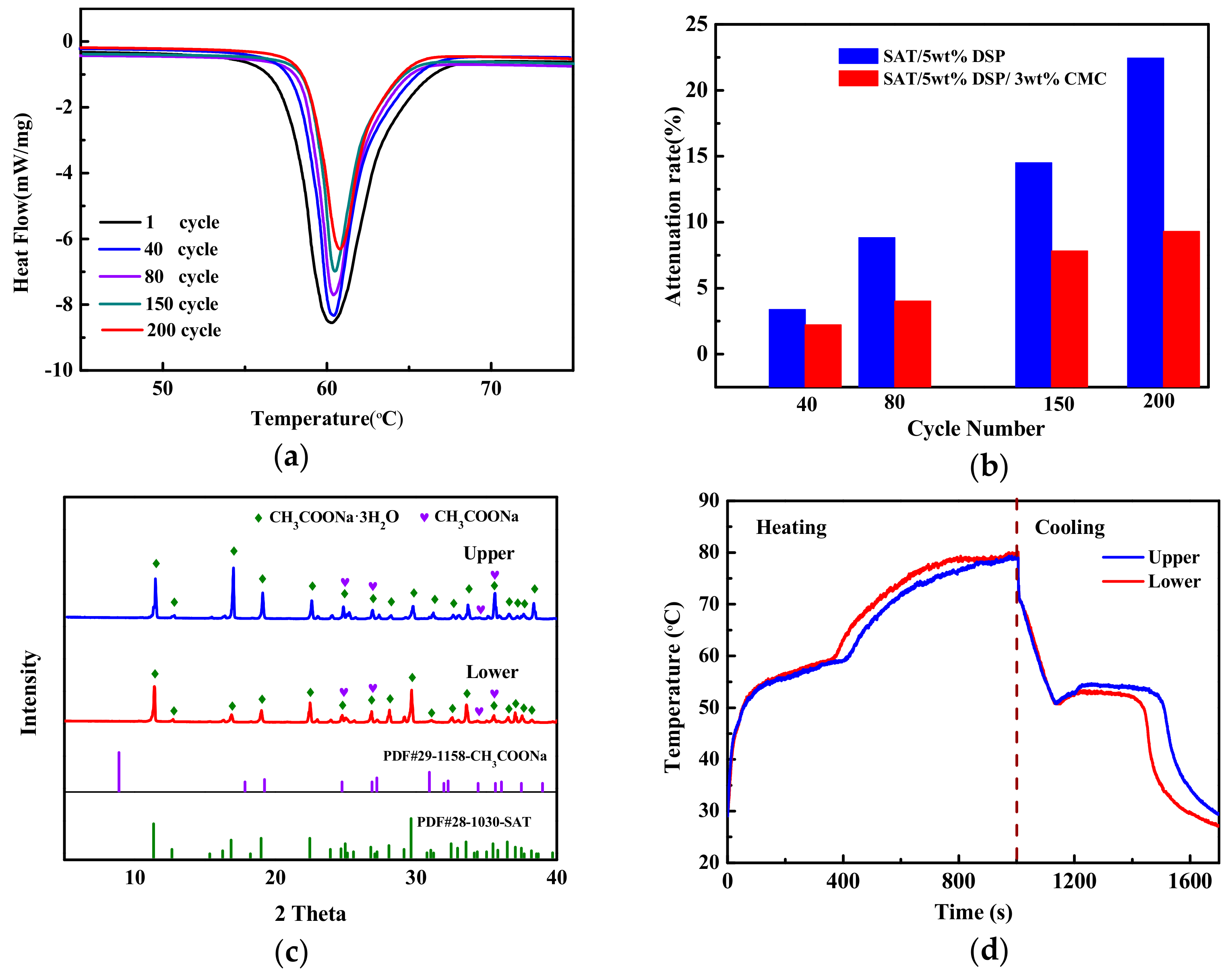
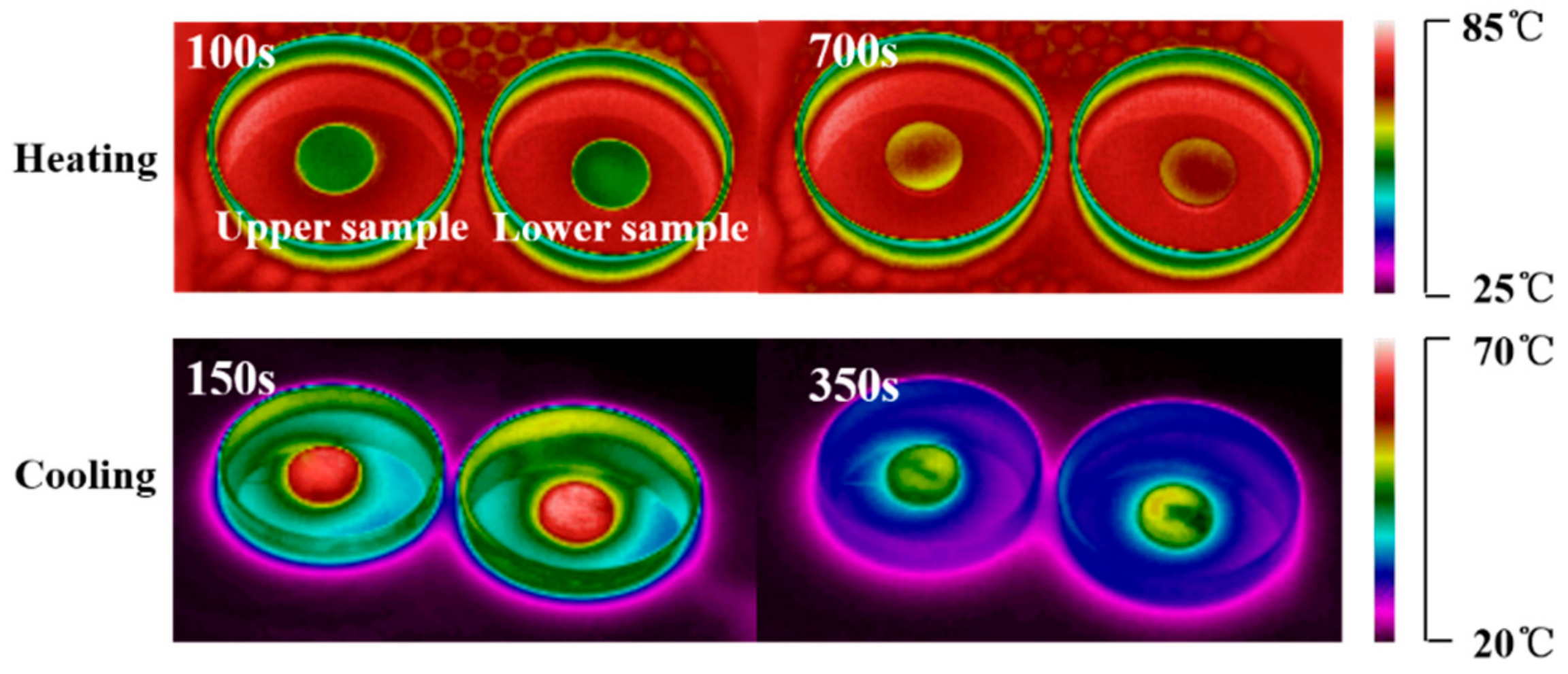
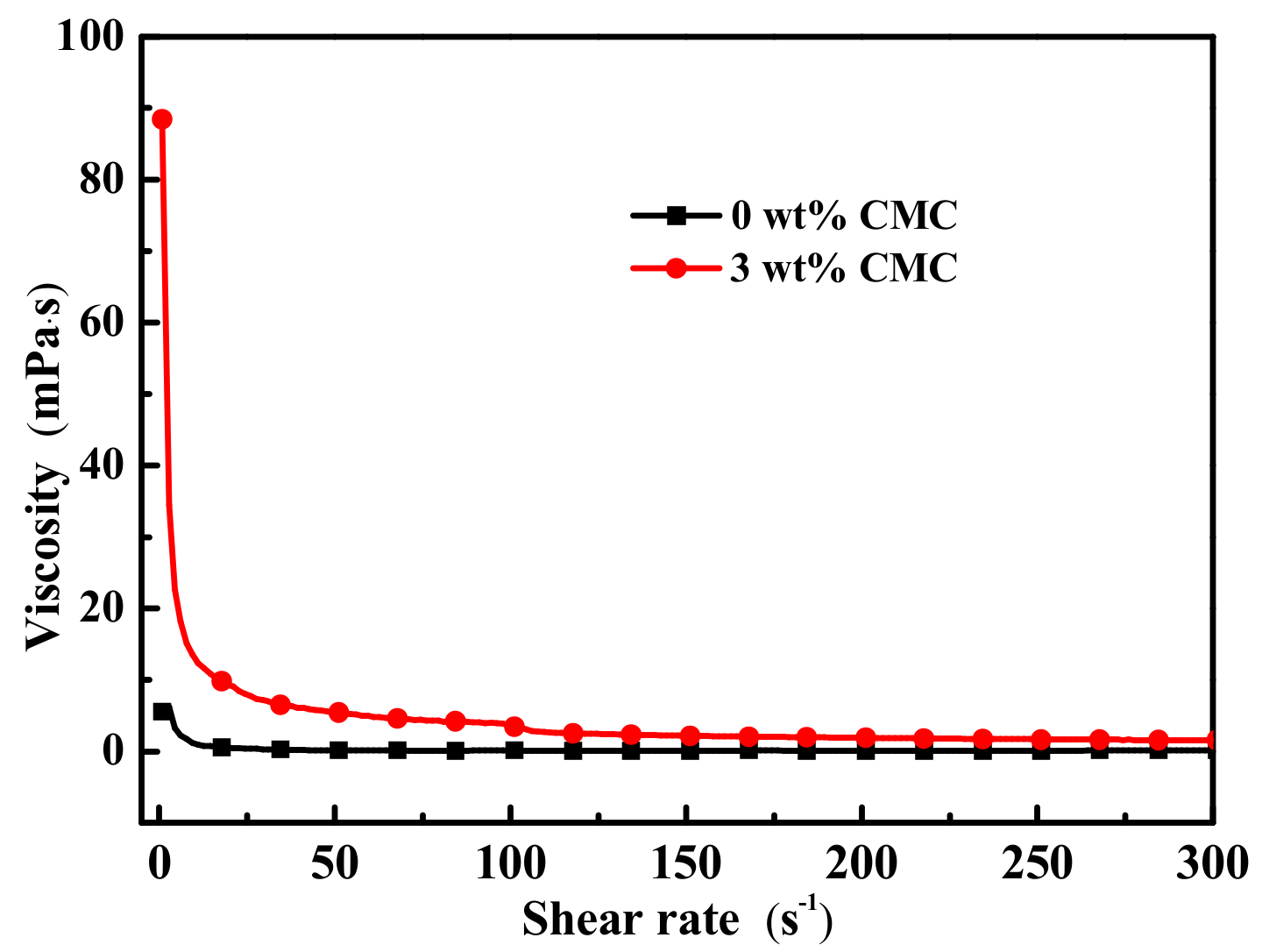
| Samples | SAT (g) | DSP (g) | CMC (g) | The mass ratio of SAT:DSP:CMC |
|---|---|---|---|---|
| 1 | 50 | 0.5 | 0 | 1:0.01:0 |
| 2 | 50 | 1.5 | 0 | 1:0.03:0 |
| 3 | 50 | 2.5 | 0 | 1:0.05:0 |
| 4 | 50 | 3.5 | 0 | 1:0.07:0 |
| 5 | 50 | 5.0 | 0 | 1:0.1:0 |
| 6 | 50 | 2.5 | 1.5 | 1:0.05:0.03 |
| Test Frequency | 40 Cycle (J/g) | 80 Cycle (J/g) | 150 Cycle (J/g) | 200 Cycle (J/g) |
|---|---|---|---|---|
| 1 | 251.84 | 236.15 | 220.73 | 199.65 |
| 2 | 253.67 | 248.23 | 233.59 | 202.37 |
| 3 | 262.98 | 239.82 | 222.64 | 203.28 |
| 4 | 259.15 | 245.83 | 228.76 | 208.43 |
| 5 | 250.51 | 235.87 | 225.08 | 212.22 |
© 2020 by the authors. Licensee MDPI, Basel, Switzerland. This article is an open access article distributed under the terms and conditions of the Creative Commons Attribution (CC BY) license (http://creativecommons.org/licenses/by/4.0/).
Share and Cite
Wu, L.; Li, J.; Wang, H.; Zhang, Y.; Feng, S.; Guo, Y.; Zhao, J.; Wang, X.; Guo, L. Experimental Investigation on Mechanism of Latent Heat Reduction of Sodium Acetate Trihydrate Phase Change Materials. Materials 2020, 13, 584. https://doi.org/10.3390/ma13030584
Wu L, Li J, Wang H, Zhang Y, Feng S, Guo Y, Zhao J, Wang X, Guo L. Experimental Investigation on Mechanism of Latent Heat Reduction of Sodium Acetate Trihydrate Phase Change Materials. Materials. 2020; 13(3):584. https://doi.org/10.3390/ma13030584
Chicago/Turabian StyleWu, Liu, Jianqiang Li, Hui Wang, Ying Zhang, Shaowei Feng, Yongchang Guo, Jianling Zhao, Xixin Wang, and Lijiang Guo. 2020. "Experimental Investigation on Mechanism of Latent Heat Reduction of Sodium Acetate Trihydrate Phase Change Materials" Materials 13, no. 3: 584. https://doi.org/10.3390/ma13030584
APA StyleWu, L., Li, J., Wang, H., Zhang, Y., Feng, S., Guo, Y., Zhao, J., Wang, X., & Guo, L. (2020). Experimental Investigation on Mechanism of Latent Heat Reduction of Sodium Acetate Trihydrate Phase Change Materials. Materials, 13(3), 584. https://doi.org/10.3390/ma13030584




